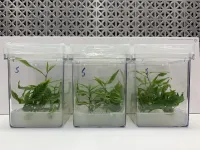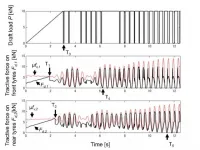(Press-News.org) As nurseries and garden centers fill up with spring landscaping plants, home gardeners owe a lot to a technique called micropropagation, which has proven beneficial to many plants - perhaps soon to include cannabis, thanks to work by UConn researchers in the College of Agriculture, Health, and Natural Resources.
Micropropagation is a technique used for growing large quantities of new plants from fewer "parent" plants, yielding clones with the same, predictable qualities. The cannabis (Cannabis sativa) industry, however, has been largely left out of this beneficial technique, because this species of plant is extremely difficult to micropropagate.
Researchers from UConn - including Associate Professor Jessica Lubell-Brand, Ph.D. student Lauren Kurtz, and Professor Mark Brand, in the Department of Plant Science and Landscape Architecture - have worked through some of the challenges of cannabis micropropagation of hemp. Their method was recently published in HortTechnology.
Currently, the commercial cannabis industry relies on other propagation techniques, such as collecting seeds or taking carefully timed cuttings from stock "mother" plants. These methods require a lot of space and maintenance, since multiple specimens of each line of stock plants must be kept in the event of disease outbreak or plant death.
"Micropropagation produces many more clones than other methods. Since it is not relying on seed, the clones are uniform, and they will perform similarly to the parent plant. Plants that come out of tissue culture also have the benefit of being disease-free, they frequently show enhanced vigor, and you can grow a lot more in less space," says Lubell-Brand.
Plants in tissue culture depend on the grower to assume the role of nature to provide the right balance of nutrients and growth hormones in the culture media, to regulate temperature and light -- everything. For some plants, micropropagation is easy to accomplish, where explants placed in the growing medium will multiply readily. For others, like cannabis, the process requires quite a bit of refining to ensure the production of a large number of healthy plants.
"Cannabis does not really want to be in tissue culture. This research is a lot of trying to figure out, What more does the plant need?" says Lubell-Brand.
Realizing the potential to help meet the needs of the rapidly growing medical cannabis industry, the researchers set out to answer this question and decipher the needs of cannabis in tissue culture. The process requires a lot of trial and error, Lubell-Brand explains.
"We start the culture using shoot tips from greenhouse-grown plants. Then we subculture those and if we suspect something is lacking, for instance, that the plant isn't getting what it needs in the media, we experiment with nutrients like calcium, magnesium, phosphorus, and nitrogen to try to increase the length of time that they grow in culture."
Lubell-Brand says one of the issues with hemp micropropagation is hyperhydricity of the shoots: when the shoots get saturated with water, they become brittle, and they don't grow well.
Lubell-Brand explains that by adjusting the media for the first six weeks in culture while also using vented vessels to increase air flow, they were able to avoid hyperhydricity.
"In addition to creating large quantities of clones of the parent plant, micropropagated plants will very likely show enhanced growth vigor compared to conventional stem propagated plants," she says.
In the medical cannabis industry, consistency and reliability in crops is highly sought after, and micropropagation could deliver both. For growers to get started with the micropropagation technique, some equipment is needed, such as an autoclave and a laminar flow bench to ensure a sterile environment. However, for operations already using tissue culture techniques, the equipment is the same, says Lubell-Brand.
Kurtz says the research has been met with some excitement: "Tissue culture is not that well worked-out for cannabis in the literature. People are aware of the complications, problems, and downfalls, so people have been pretty receptive to the paper."
Lubell-Brand says the research is continuing, with Kurtz planning further studies to refine the process, such as determining the optimal timing of rooting and the length of time shoots can remain in culture.
The cultivars the researchers are working with are cannabidol (CBD) cultivars lacking psychoactive amounts of tetrahydrocannabinol (THC), but their micropropagation technique can be applied to THC-dominant cultivars as well. One day, maybe not so far in the future, the majority of cannabis may be micropropagated using tissue culture, though Lubell-Brand says there are still improvements to be made.
"Despite all our efforts, it's still not easy to grow cannabis in tissue culture. However, now we can multiply shoots, root shoots, and transition them from the lab to the greenhouse, which is a step forward."
INFORMATION:
May 4, 2021 - From the very beginning of the AIDS epidemic in 1981, nurses have been at the forefront of patient care, advocacy, and research. But even in the age of antiretroviral therapy and pre-exposure prophylaxis, many challenges remain in reducing the impact of HIV and AIDS, according to the special May/June issue of END ...
Relatives of the giant crocodile might have been kings of the waterways during the Cretaceous period, eating anything--including dinosaurs--that got a little too close to the water's edge, but the largest of these apex predators still started off small. Figuring out how these little crocs grew up in a world surrounded by giants is no small task. Now crocs fossils from Texas are shedding light on how these animals changed their diets as they grew, helping them find a place of their own in environments alongside their bigger, badder relatives.
According to the study, published by Cambridge University Press, the crocodiless in question are members of the Deltasuchus motherali and lived along the coastline of Texas 96 million years ...
Scientists have shed light on why some people who have a stroke do not also have abnormal heart rhythms, even though their hearts contain similar scar tissue.
Their results, published today in eLife, could help identify the best treatments for people who might be at risk of recurrent stroke, new heart disorders, or both.
Strokes are often caused by abnormal blood flow resulting from rapid, irregular beating in the upper chamber of the heart. This is also called atrial fibrillation (AFib). But some people have strokes that appear to have been caused by the heart, ...
Aachen, Germany and Hennigsdorf/Berlin, Germany, May 4, 2021 - German University Hospital Uniklinik RWTH Aachen ("Uniklinik RWTH Aachen") and diagnostics company SphingoTec GmbH ("SphingoTec") today announced that the endothelial function biomarker bio-ADM aids in the early risk stratification and management of patients suffering from severe COVID-19, in need for escalated intensive care treatment (1). A team lead by the clinical researchers at Uniklinik RWTH Aachen has shown that high bio-ADM levels indicate the severity of the acute respiratory distress ...
Tokyo, Japan - Researchers at Tokyo University of Agriculture and Technology (TUAT) modeled the dynamic instability--the so-called "power hop"--that can cause uncontrollable bouncing and damage tractors when they plow dry ground. The team found that self-excited oscillations can arise when the tractor pushes against the ground.
Plowing a field on a tractor may seem like a serene occupation, but sudden vibrations can grow unexpectedly and threaten to topple you under certain conditions. The problem is that in nonlinear systems with coupled components, as with a mechanical tractor, ...
A synthetic approach that improves absorber layers in perovskite solar cells could help them achieve their full potential and draw closer to the performance of leading gallium arsenide devices.
Solar cells that rely on perovskite thin films to capture sunlight are the fastest growing photovoltaic technology. Cheaper and easier to manufacture and incorporate into devices than conventional semiconductors, lead halide perovskites also effectively absorb visible light and display long charge carrier diffusion lengths -- an indicator of their ability to maintain light-induced electrons and holes separation and facilitate charge transport.
Performance ...
A new Boston University School of Public Health (BUSPH) study has identified for the first time how the aryl hydrocarbon receptor (AhR), an environmental chemical receptor, drives immunosuppression in oral squamous cell carcinoma (OSCC)--and that its removal from malignant cells can result in tumor rejection.
Published in the journal Proceedings of the National Academy of Sciences, the study findings provide new insight into the biology of cancer immunosuppression, and identify a new target for cancer immunotherapy treatment.
Immune checkpoint inhibitors (immunotherapy drugs) are some of the most important treatments that have emerged for treating many cancers, including OSCC. Targeting immune checkpoint molecules such as PD-1, ...
Measures to contain the Corona pandemic are the subject of politically charged debate and tend to polarize segments of the population. Those who support the measures motivate their acquaintances to follow the rules, while those who oppose them call for resistance in social media. But how exactly do politicization and social mobilization affect the incidence of infection? Researchers at the Max Planck Institute for Human Development have examined this question using the USA as an example. Their findings were published in Applied Network Science.
Limit crowds, keep a safe distance, and wear masks. Such non-pharmaceutical ...
Cancerous tumors thrive on blood, extending their roots deep into the fabric of the tissue of their host. They alter the genetics of surrounding cells and evolve to avoid the protective attacks of immune cells. Now, Penn State researchers have developed a way to study the relationship between solid, difficult-to-treat tumors and the microenvironment they create to support their growth.
The method has the potential to act as a testbed for drugs and other anticancer treatments, according to Ibrahim T. Ozbolat, associate professor of engineering science and mechanics and biomedical engineering, who led the research. The details of the approach were published in Advanced Biology.
Using ...
Despite human inventiveness and ingenuity, we still lag far behind the elegant and efficient solutions forged by nature over millions of years of evolution.
This also applies for buildings, where animals and plants, have developed extremely effective digging methods, for example, that are far more energy-efficient than modern tunnelling machines, and even self-repairing foundations that are unusually resistant to erosion and earthquakes (yep, we're talking about roots here).
Researchers from all over the world are therefore seeking inspiration in nature to develop the buildings of the future, and researchers from Aarhus University ...


